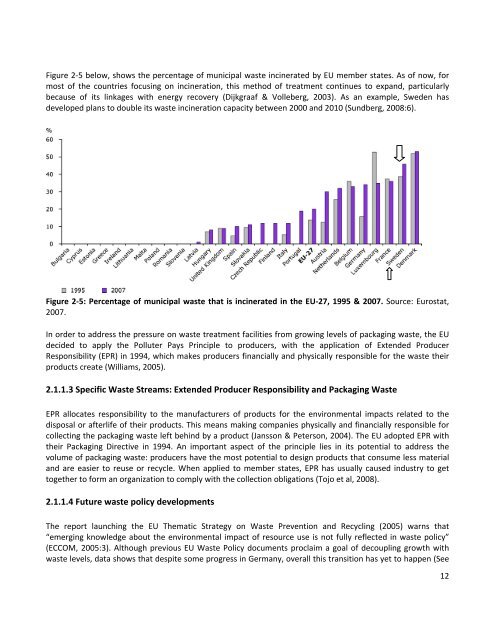Waste prevention and Pay as You Throw, a collective case ... - lumes
Waste prevention and Pay as You Throw, a collective case ... - lumes
Waste prevention and Pay as You Throw, a collective case ... - lumes
You also want an ePaper? Increase the reach of your titles
YUMPU automatically turns print PDFs into web optimized ePapers that Google loves.
Figure 2‐5 below, shows the percentage of municipal w<strong>as</strong>te incinerated by EU member states. As of now, for<br />
most of the countries focusing on incineration, this method of treatment continues to exp<strong>and</strong>, particularly<br />
because of its linkages with energy recovery (Dijkgraaf & Volleberg, 2003). As an example, Sweden h<strong>as</strong><br />
developed plans to double its w<strong>as</strong>te incineration capacity between 2000 <strong>and</strong> 2010 (Sundberg, 2008:6).<br />
Figure 2‐5: Percentage of municipal w<strong>as</strong>te that is incinerated in the EU‐27, 1995 & 2007. Source: Eurostat,<br />
2007.<br />
In order to address the pressure on w<strong>as</strong>te treatment facilities from growing levels of packaging w<strong>as</strong>te, the EU<br />
decided to apply the Polluter <strong>Pay</strong>s Principle to producers, with the application of Extended Producer<br />
Responsibility (EPR) in 1994, which makes producers financially <strong>and</strong> physically responsible for the w<strong>as</strong>te their<br />
products create (Williams, 2005).<br />
2.1.1.3 Specific <strong>W<strong>as</strong>te</strong> Streams: Extended Producer Responsibility <strong>and</strong> Packaging <strong>W<strong>as</strong>te</strong><br />
EPR allocates responsibility to the manufacturers of products for the environmental impacts related to the<br />
disposal or afterlife of their products. This means making companies physically <strong>and</strong> financially responsible for<br />
collecting the packaging w<strong>as</strong>te left behind by a product (Jansson & Peterson, 2004). The EU adopted EPR with<br />
their Packaging Directive in 1994. An important <strong>as</strong>pect of the principle lies in its potential to address the<br />
volume of packaging w<strong>as</strong>te: producers have the most potential to design products that consume less material<br />
<strong>and</strong> are e<strong>as</strong>ier to reuse or recycle. When applied to member states, EPR h<strong>as</strong> usually caused industry to get<br />
together to form an organization to comply with the collection obligations (Tojo et al, 2008).<br />
2.1.1.4 Future w<strong>as</strong>te policy developments<br />
The report launching the EU Thematic Strategy on <strong>W<strong>as</strong>te</strong> Prevention <strong>and</strong> Recycling (2005) warns that<br />
“emerging knowledge about the environmental impact of resource use is not fully reflected in w<strong>as</strong>te policy”<br />
(ECCOM, 2005:3). Although previous EU <strong>W<strong>as</strong>te</strong> Policy documents proclaim a goal of decoupling growth with<br />
w<strong>as</strong>te levels, data shows that despite some progress in Germany, overall this transition h<strong>as</strong> yet to happen (See<br />
12
















